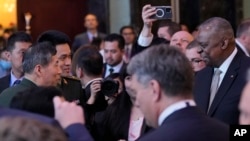WASHINGTON —Renewed calls by Chinese officials for the lifting of sanctions in exchange for open lines of communication with the U.S. military are echoing into a diplomatic abyss, even as tensions between the two superpowers continue to mount.
The Pentagon on Thursday rejected the demand, arguing there is no good reason for high-level Chinese military officials to avoid conversations with their U.S. counterparts.
“From our perspective, there are no obstacles to keeping open lines of communication,” the Pentagon press secretary, Brigadier General Patrick Ryder, told reporters, responding to a question from VOA.
U.S. Defense Secretary Lloyd Austin “can communicate with his Chinese counterpart right now,” Ryder added. “Those sanctions do not need to be lifted in order for him to communicate with his counterpart.”
Austin and Chinese Minister of National Defense Li Shangfu spoke briefly during the annual Shangri-La Dialogue in Singapore earlier this month, but Pentagon officials described the exchange as not substantive.
Chinese officials have repeatedly said they would be open to talks, but only if sanctions are lifted, a demand they repeated Wednesday, according to Bloomberg News.
“The U.S. side knows the reason for difficulties in its military-to-military relations with China,” Liu Pengyu, the spokesman for China’s embassy in Washington, told reporters.
“Such obstacles should be removed before any exchange and cooperation could take place between the two countries,” he added.
Liu did not specify the sanctions China wants lifted, but Chinese officials have previously pointed to personal sanctions on Li as the sticking point.
China’s spy balloon
High-level military-to-military communications between the two counties have been on hold since before China sent a high-altitude surveillance balloon across the United States in February.
Pentagon officials said China’s military rejected a request to talk after the balloon was shot down and have expressed concern that other U.S. calls for talks have fallen on deaf ears.
Chinese officials deny that the high-altitude balloon, which was ultimately shot down off the U.S. Atlantic coast, was a surveillance device, arguing instead it was a weather balloon.
But the Pentagon insisted Thursday the balloon was intended for surveillance, though U.S. countermeasures appear to have thwarted its collection efforts.
“It has been our assessment now that it did not collect while it was transiting the United States," Ryder told reporters. “Certainly, the efforts that we made contributed, for sure.”
Ryder, though, declined to comment directly on a report by The Wall Street Journal that the balloon equipment included U.S.-made technology.
He also did not rule it out.
“We are aware in previous cases, for example, things like drones and other capabilities, what have you, where off-the-shelf commercial U.S. components have been used,” he said.
The report alarmed some U.S. lawmakers, who called for more limits on technology exports to China.
“This incident has not been closed,” Representative Michael McCaul and Senator Bill Hagerty, both Republicans, said in a statement. “We look forward to viewing the full technology analysis of the surveillance balloon. Competitive actions, like export controls, must move forward to stand up to Communist China.”









